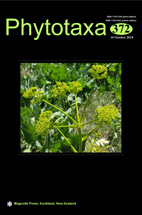Abstract
Gnidia sisparensis Gardner (1847: 457–458) was first described based on (at least) two collections made from Sispara Pass in the Nilgiri Mountains in southwestern India. Wight (1852: 18, text explanation sub plate 1860) translated the original Latin description of G. sisparensis into English (almost verbatim), adding the following comment: “In its general aspect this plant is so like the other [i.e. G. eriocephala Wall. ex J. Graham (1839: 176)] that it might be passed as such, but on closer examination it proves a very distinct species”. In that publication, Wight also provided the first illustrations of G. sisparensis (plate 1860), and the plant closely matches the description included in Gardner’s protologue. Without personally examining any specimen, Meisner (1857) transferred the species to the very closely related genus Lasiosiphon Fresenius (1838: 602–603), creating L. sisparensis (Gardner) Meisner (1857: 598), on the basis of the protologue (Gardner 1847) and the plate published in Wight (1852). Hooker (1886: 197) synonymized L. sisparensis and several other names [e.g. Lasiosiphon hugelii Meisner (1857: 598), L. metzianus Miquel (1851: 15), G. insularis Gardner (1847: 456)] under a broadly circumscribed L. eriocephalus (Wall. ex J. Graham) Decaisne (1844: 148), noting that there were no distinguishing characters available to separate them. Later, Gamble (1925) cited Gardner’s Sispara material along with two other collections from Palghat Hills (=Palakkad) and Mysore (=Mysuru), made by Beddome and Lobb, respectively. Additionally, Gamble (1925) recognized the taxon at the varietal rank as L. eriocephalus var. sisparensis (Gardner) Gamble (1925: 1244), mentioning differences related to leaf shape and the color of the trichomes within the inflorescences. Townsend (1981) was the first to treat L. eriocephala, and its basionym, Gnidia eriocephala, as synonyms of the widespread African Gnidia glauca (Fresenius 1838: 603) Gilg (1894: 227) [≡ Lasiosiphon glaucus Fresenius(1838: 603)], writing on page 506 that the “Indian material is often more abruptly and less sharply pointed in the leaf than African, but this is by no means consistent”. Additionally, Townsend recognized two infraspecific taxa of G. glauca, the var. glauca, ranging from Southwest India to tropical Africa (Mozambique, Malawi, Zambia, through Sudan and Ethiopia and west to Nigeria), and var. insularis (Gardner) Townsend (1981: 507), a more pubescent Sri Lankan variety (Gnidia sisparensis was not mentioned in the publication). Kumari (1987) recognized that Townsend’s treatment implied a transfer of L. eriocephalus var. sisparensis to Gnidia, and published the new combination G. glauca var. sisparensis (Gardner) Kumari (1987: 214). Kumari went on to indicate the Ramanathapuram District of Tamil Nadu as its native range, without citing any voucher specimens. Moreover, Naithani (1990) also recognized the variety and extended its distribution, reporting three adjacent Indian states (Tamil Nadu, Karnataka, Kerala), but likewise without citing any supporting vouchers.
Gnidia sisparensis is reinstated here as a distinct species and a lectotype is designated for the name.

